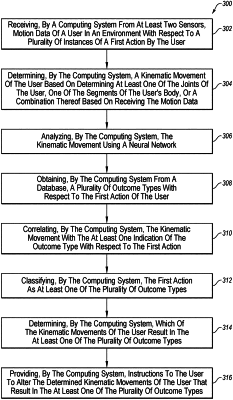| CPC A63B 71/0622 (2013.01) [A63B 24/0006 (2013.01); G09B 19/0038 (2013.01); A63B 2024/0015 (2013.01); A63B 2024/0068 (2013.01); A63B 2071/0647 (2013.01); A63B 2071/0694 (2013.01); A63B 2102/32 (2015.10); A63B 2220/05 (2013.01); A63B 2220/803 (2013.01); A63B 2220/806 (2013.01); A63B 2220/807 (2013.01); A63B 2220/89 (2013.01); A63B 2225/50 (2013.01)] | 20 Claims |

|
1. A method, comprising:
receiving, by a computing system from at least two sensors, motion data of a user in an environment with respect to a plurality of instances of an action by the user;
determining, by the computing system, a kinematic movement of the user based on determining at least one of a joint of the user, a body segment of the user's body, or a combination thereof based on the motion data;
analyzing, by the computing system, the kinematic movement using a neural network;
obtaining, by the computing system, from a database, a plurality of outcome types with respect to the action of the user;
correlating, by the computing system, the kinematic movement with at least one indication of an outcome type with respect to the action;
classifying, by the computing system, an outcome of the action as at least one of the plurality of outcome types;
determining, by the computing system, which of kinematic movements of the user that result in the at least one of the plurality of outcome types;
overlaying the determined kinematic movements with respect to the plurality of instances of the action on one another;
displaying, a visualization of the overlaid determined kinematic movements of the user with respect to the plurality of instances of the action by the user; and
providing, by the computing system, instructions to the user to alter the determined kinematic movements of the user that result in the at least one of the plurality of outcome types.
|